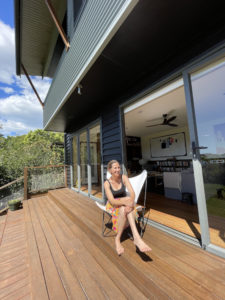When art advisor Miriam Grundy and her family first moved into an ecovillage near the Gold Coast in Queensland a year ago, living without a general waste bin took a bit of getting used to.
“It really makes you think about everything you usually just put in a curb side bin and forget about.”
Fast forward 12 months and Miriam has become something of a composting enthusiast. She’s even been known to take other people’s scraps home, she jokes.
There’s a shared recycling centre onsite and the family also process things like cardboard themselves by turning it into weed matting, but

Miriam Grundy at her Currumbin Ecovillage
the focus is on avoiding waste altogether, which boils down to using reusable products and shopping at bulk food stores.
“Everything you bring into the house – you have to take it back out.”
Miriam and her partner Elliott Wheeler stumbled upon the Currumbin Ecovillage on accident. After living in the US for many years, the pair wanted to bring up their two small children on a bit of land somewhere quiet and leafy.
They knew very little about the ecovillage when they made an offer on the comfortable, understated home on an acre block (about 4000 square metres). But they were pleased to discover that they had bought into the semi rural precinct of an ecovillage that had been established around 15 years ago.
The couple have since purchased a second property in the ecovillage for Elliott’s work.
Their section of the ecovillage offers residents a bit more space and privacy, whereas the homes in the original section are closer together so that people can live within walking distant of the common areas, such as the pool and workshop. The idea is that one pool between many is a better use of resources than a pool in every backyard, Miriam explains, and also fosters social connection.
In the denser precinct, groups of six-to-eight homes form a hamlet, with each hamlet responsible for a little patch of communal land to do with whatever they wish. This little slice of group decision-making might have fruit trees, play equipment or any myriad of things, Miriam says.
Development in the ecovillage is bound by sustainability-focused covenants. These rules dictate what can and cannot be built, ranging from the thermal performance to the muted colour palette. A design committee ensures any new construction aligns with these principles.















